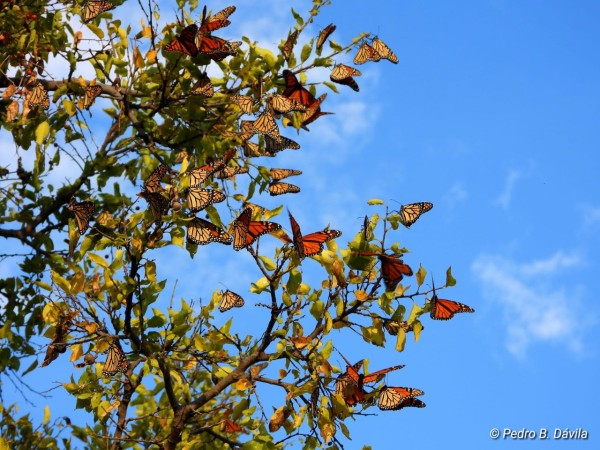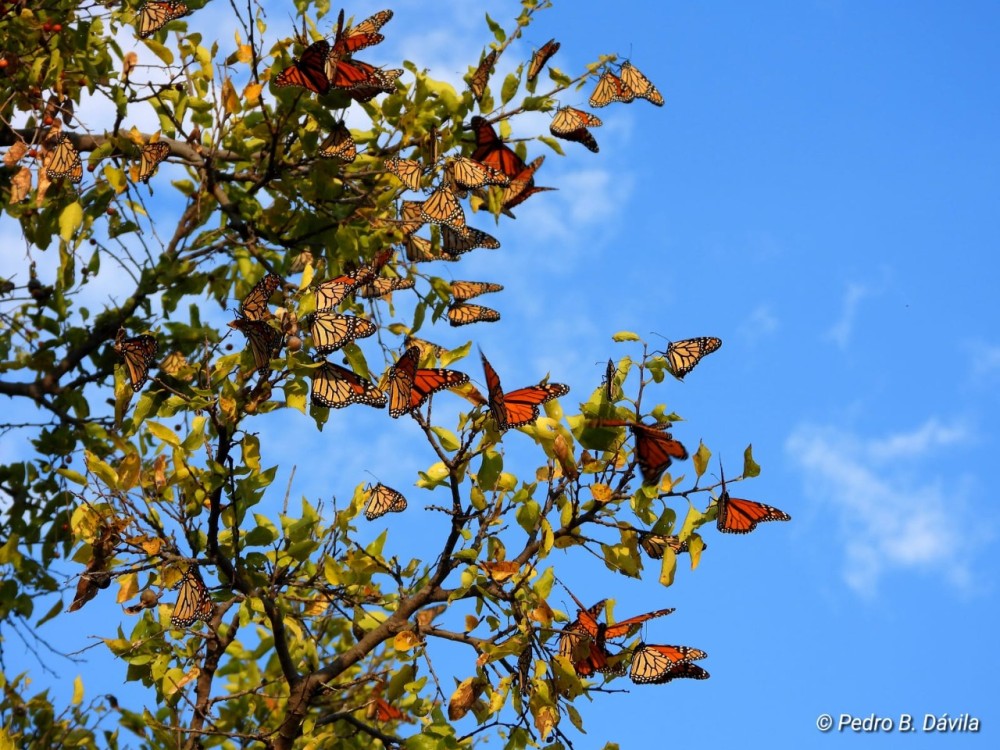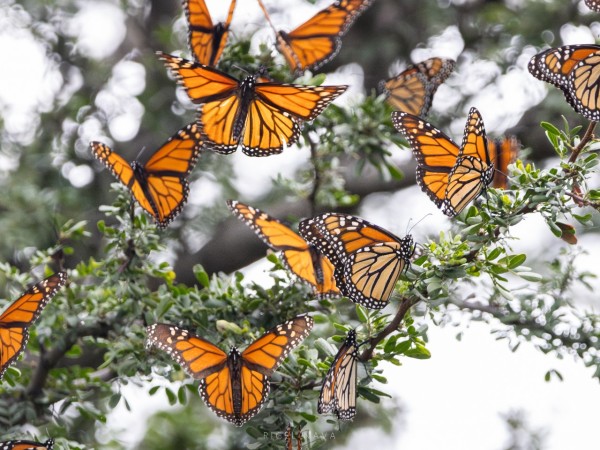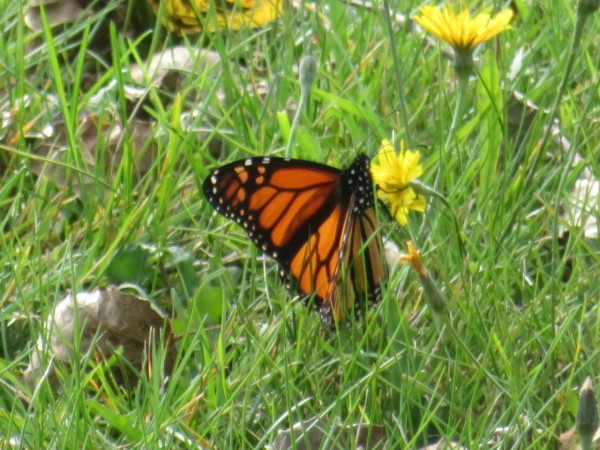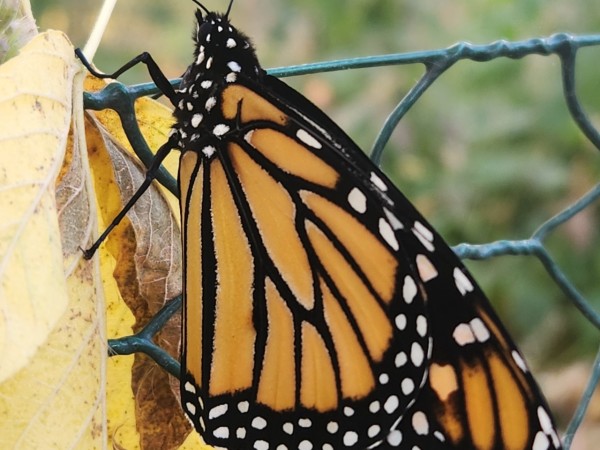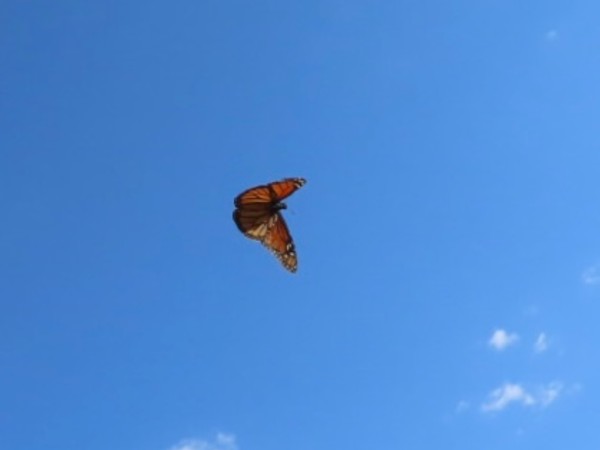Reports from California overwintering sites, roosting in Mexico
Monarchs reaching Mexico, approaching overwintering sites
It’s only a matter of time until eastern monarchs begin to reach their overwintering sites. This weekend, we received our largest fall roost report from Mexico so far this season.
In San José de la Joya, Pedro Benjamín Dávila Valdés reported over 1,000 monarchs to Correo Real on Oct. 19 with a photo, which Correo Real shared with us in a Journey North report.
Just west of Monterrey, in García, Rigel Nava submitted a report to Correo Real on Oct. 20:
“En la mañana del domingo con una niebla espesa, mis compañero caminantes y yo, nos dirigimos a la Cascada del Cañon de la Mota Chica y, de regreso a las 15:30 horas encontramos un árbol con una percha de 50 monarcas, seguía nublado con una temperatura de 20°C. Posiblemente ahí pernoctaron las monarcas y nos las vimos en temprano en la mañana por la niebla y poca luz.”
“On Sunday morning with thick fog, my fellow hikers and I headed to the Mota Chica Canyon Waterfall and, on our return at 3:30 p.m., we found a tree with a perch of 50 monarchs. It was still cloudy with a temperature of 20°C. Possibly the monarchs spent the night there and we saw them early in the morning due to fog and poor light.”
As the crow (or monarch) flies, San José de la Joya is only about 400 miles from the Monarch Butterfly Biosphere Reserve, where monarchs could be arriving any day now.
Still remaining in the north
While monarch lovers in Mexico are preparing for the monarchs’ arrival, the trend of this summer and fall's late season continues despite some cooler temperatures in the past week.
Some of the most northerly confirmed sightings this week have come to us from northeastern Canada, with reports from New Brunswick and Nova Scotia. On Oct. 21, Melissa reported a monarch on red leaves in River John, Nova Scotia (latitude 45.8), the week’s northernmost monarch report.
In Eagan, Minnesota, just south of the Twin Cities, Nick reported an adult hatching on Oct. 22. That’s already 11 days later than last year’s latest monarch report, which came from Joel in Willmar on Oct. 11.
We’ll see how late monarchs remain in northern locations. Let us know what you’re seeing, and don’t forget to include a photo with your report. While it’s not required, photos help confirm that sightings are of monarchs, not lookalikes such as viceroys or queens.
Report overwintering monarchs in the southern U.S.
As we approach the winter, it’s also worth mentioning that some monarchs will overwinter in southern states. Florida’s overwintering population is the most well-known, but states like Texas, Louisiana, Mississippi, Alabama, Georgia and the Carolinas may also host winter monarchs.
It’s especially useful to us to receive reports of eggs and caterpillars to confirm that breeding is occurring.
Western Monarchs Update
By Gail Morris
Monarchs are slowly beginning to arrive at some of the California coastal overwintering sites! So far, the number of monarchs appearing is lower than in earlier years. As the late heat wave loosens its grip, the southwest states are all reporting a late wave of monarchs migrating through the region. The first small cluster in the West was reported as well.
Recent Monarch Sightings
An uptick of monarchs was reported in Utah, Arizona, Nevada and California this past week.
Carol in Baker, Nevada, was surprised on October 10 when a monarch flew above heading west. Two days later, Joanne in Jensen, Utah saw a monarch, much later than a previous last sighting date of Sept. 20.
Adrienne in Salt Lake City, Utah reported one monarch on October 15: “Female nectaring on Buddleia. looks fresh. could have eclosed in my waystation yard or other gardens in neighborhood that have milkweed or from antelope horn milkweed up the hill on the bench public lands.”
Della in Phoenix, Arizona, found her first monarch on October 15, reporting "one female in good condition flying around my yard. Not stopping on flowers, just circling front to back of house."
Della reported previous first sightings of the seasons on Oct. 2, 2023, Sept. 4, 2021 and Sept. 16, 2020.
In nearby Superior, Arizona, just to the east of Phoenix, Vicki spotted four monarchs in a pollinator garden on Oct. 11.
Erica’s father shared some exciting news with her on Oct. 5 – monarchs were clustering in his yard!
“I'm sharing on behalf of my dad who lives in Chico, CA," Erica wrote. "He said he had hundreds of Monarchs in his backyard and sent me this picture.” (Be sure to see Erica’s photo of 100 monarchs clustering!)
From the Field
Diana Magor, Santa Cruz, California
“Beth Bell Dayton and I did the second monarch count at Lighthouse Field on Friday, Oct. 18.
It was a very windy and warm day, and monarchs were already flying when we started our survey with a new student, Liana Crabtree at 9 a.m. We counted 103 roosting monarchs and estimated 20 flyers. Upon reviewing photos on a bigger screen than my camera, I found one tag on the left wing of a clustered monarch, but could not read it nor did I find it on three returns to the site. Still looking.
The next morning was cold so I went out to get a more accurate survey, and found a total of 159 from 8 to 9:30 a.m. on Oct. 19.
The prior evening, I observed about100 monarchs either flying into the sanctuary or lifting off their roosts as others flew in or both at 5:36 p.m. Dorothy Pedersen, another observer there, has seen them fly in every evening about that time, sometimes in larger numbers. They flew about looking for a suitable roost for the night, and finally settled with no more activity after sunset at 6:30.
We will do surveys every week during the overwintering season.”
Gail Morris is the Coordinator of the Southwest Monarch Study (www.swmonarchs.org). She is also a Monarch Watch conservation specialist, the vice president of the Central Arizona Butterfly Association and sits in several western working groups. The Western Monarch News is based on comments provided to Gail Morris. You can reach her at gail@swmonarchs.org.
